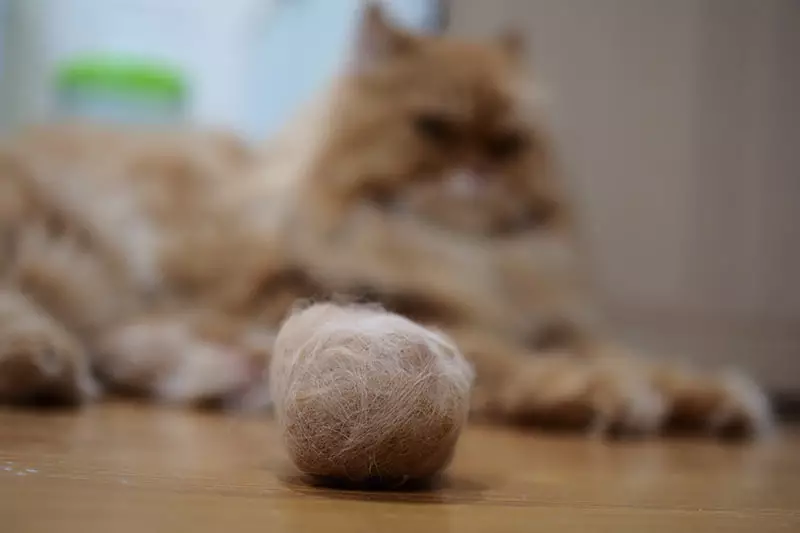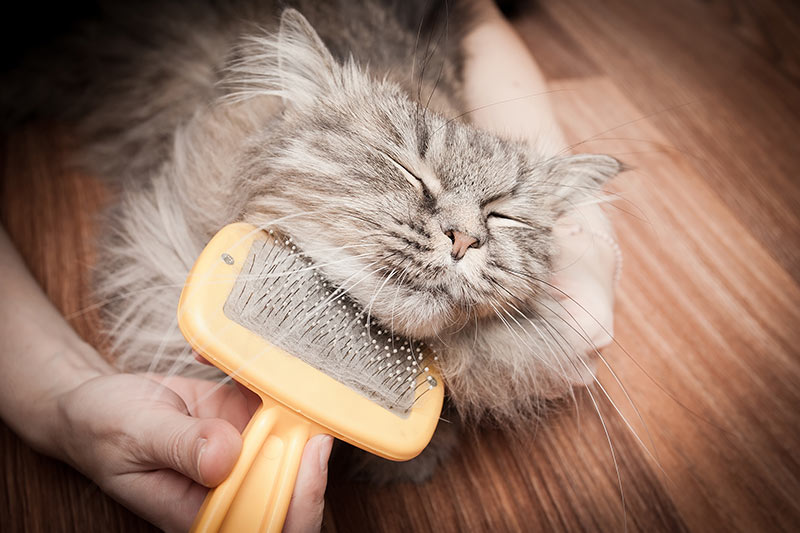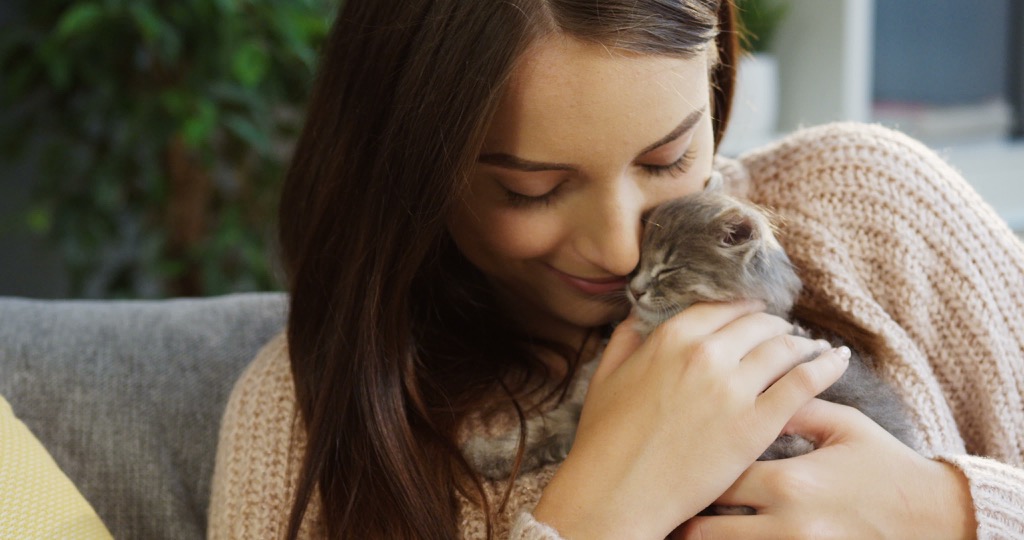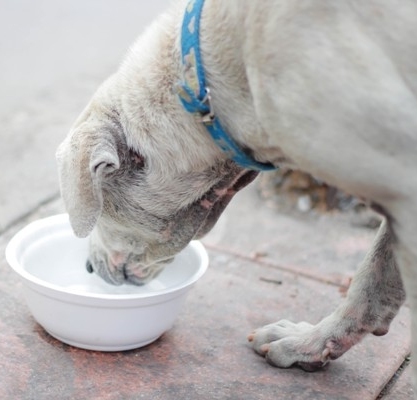Trichobezoar (Hairball obstruction) in cats
What is it?
A trichobezoar, also known as a hairball or furball, is a long cylindrical mass of hair that forms in the stomach. It is normal for cats to vomit up the occasional trichobezoar, particularly longer haired cats. However, if this happens frequently, or suddenly starts to occur in an older cat, it may be a sign of a more serious problem.
Cats groom themselves with their rough tongues, which have tiny hook-like barbs that catch the loose hair and foreign bodies in their coats, much like a brush. This hair is swallowed, and much of it passes through the digestive tract and is eliminated in the faeces. Sometimes hair stays in the stomach and coalesces in a trichobezoar. Usually, the cat will vomit up the trichobezoar to get rid of it.
Trichobezoars are the most common cause of vomiting in cats. It can be distressing for owners to observe their cat produce a trichobezoar, and rather unpleasant to clean it up.

What are the symptoms?
The most common signs seen by owners are:
- Vomiting of food, mucus and / or hairballs
- Retching, gagging or hacking, prior to vomiting
- Reduction of appetite
- Constipation
In severe situations, the trichobezoar is not vomited up but remains in the stomach and hardens into a dense mass, which can irritate the stomach or even cause an intestinal blockage. Long-haired breeds have a greater risk of this occurrence.
Blockage of the intestines by a trichobezoar may have the following symptoms:
- Repeated vomiting
- Ongoing retching, gagging or hacking without producing a trichobezoar
- Abdominal pain and discomfort
- Lethargy
- Constipation
- Diarrhoea
What is the cause?
Trichobezoars develop from a cat’s normal or excessive grooming. As the cat’s gut is designed to act like a brush to remove dead hairs from its coat, the occasional trichobezoar is normal. However, multiple trichobezoars should not be a common occurrence in a healthy cat and may be the sign of an underlying problem.
Trichobezoars can result from a combination of different factors, which in most cases relate to the quantity of hair consumed and/or the passage of the hair through the digestive tract:
- Increased grooming – for example, in the case of skin problems or irritation
- Excessive or compulsive grooming – for example, from boredom or a behavioural problem such as anxiety
- Seasonal changes – additional hair is shed
- Indoor / sedentary lifestyle –
- physical inactivity can slow the passage of food and hair through the digestive tract
- lack of opportunity to ingest the ballast that naturally stimulates the movement of hair through the intestines
- Breed – Long-haired breeds, such as Persians and Maine Coons, tend to have more trichobezoars
- Motility disorders or the presence of “retention” pockets in the digestive tract, which affect the ability to move food through the digestive tract
- Inflammatory bowel disease
- Intestinal obstruction
In the latter cases, the trichobezoar should be seen as a symptom of an underlying problem, rather than a problem in its own right, and the underlying problem needs to be detected and treated, rather than the trichobezoar itself.

How is it diagnosed?
Occasional trichobezoars vomited up by your cat are normal, and usually do not require further diagnostics. However, it is important to visit the vet urgently in the following situations:
- Trichobezoars are occurring frequently
- Trichobezoars are occurring repeatedly for more than 24 hours
- If you cat is vomiting and coughing without bringing up a trichobezoar
- If your cat is in obvious pain and discomfort
- If it is a new occurrence in an older cat
Diagnostic tests in more serious cases of trichobezoars may include:
- Routine blood screens, such as:
- A complete blood cell count – to evaluate red and white blood cell counts and morphology
- A blood chemistry profile – to evaluate kidney and liver function, serum electrolytes (e.g. sodium, calcium, phosphorus), blood protein levels and blood glucose levels
- Thyroid screening – a total T4 test
- Urinalysis – to further evaluate kidney and function and urinary tract function
- Faecal examination – to check for intestinal parasites
- Gastric endoscopy
Other diagnostic tests may be recommended, depending on the results of the above tests, for example:
- Abdominal x-ray and / or ultrasound
- Endoscopic examination of the intestinal tract
What is the treatment?
There is no treatment that will completely prevent the occurrence of trichobezoars. There are a few different remedies that may reduce the number or frequency of trichobezoars. These may work for some cats but are not effective in all cases.
Common treatments and preventative measures for trichobezoars include:
- Medications / laxatives
- Mineral oil, paraffin oil and petroleum-based treatments
- Usually given weekly, these claim that a lubricated trichobezoar will pass more easily out of the stomach and through the intestinal tract.
- “Hairball formula” cat food
- Special commercial cat foods and treats that claim to prevent and / or control trichobezoars
- These are high in fibre, which is assumed to help bind the hair and stimulate the gastrointestinal tract to move the trichobezoar along.
- Dietary modification
- a grain-free diet may be beneficial for cats that vomit frequently.
- Grain based foods are high in carbohydrates, which can change the gut flora, or bacteria, of the cat’s intestinal tract, which may affect the cat’s ability to pass hair normally through the intestinal tract.
- Grooming
- Regular brushing and combing of your cat and using a de-shedding tool can help prevent
- Removal of loose hair before your cat has the chance to ingest it will reduce the amount of ingested hair and lower the number of trichobezoars produced.
- Discourage your cat from self-grooming excessively – provide distractions and other enjoyable activities instead.
- Surgery
- Enterotomy on the ileum (small intestine) may be performed in extreme cases to remove a trichobezoar
- If an underlying or contributing cause has been detected, such as parasites, bacterial overgrowth or IBS (Irritable Bowel Disease), treatment for these conditions will be prescribed.
If you like to learn more on how to avoid hairballs, watch this video: “Avoid Hair Balls” – https://pets.webmd.com/cats/video/avoid-hair-balls

Overview
Trichobezoars are cylindrical masses of ingested hair that commonly occur in cats. They may result from a combination of factors including hair length, shedding patterns, dietary factors and digestive issues. Recurrent trichobezoars in an apparently healthy cat may indicate an underlying problem that should be investigated by your vet.
Bow Wow Meow Pet Insurance can help protect you and your cat should an unexpected trip to the vet occur.
-
Find out more about our cat insurance options
-
Get an online pet insurance quote
Bow Wow Meow is proud to have been awarded winner of Canstar’s ‘Most Satisfied Customers’ Award in the Pet Insurance category for both 2024 and 2025!
Bow Wow Meow is proud to have been chosen as Product Review’s Pet Insurance Award Winner every year from 2018 to 2025! This is based on 2,995 independent customer reviews (as at 21/01/2025), with an overall rating of 4.3*
Google Review rating = 4.5* (based on 968 reviews)
Trust Pilot rating = 4.6* (based on 531 reviews)
Bow Wow Meow is proud to have been chosen as Product Review’s Pet Insurance Award Winner every year from 2018 to 2025! This is based on 2,995 independent customer reviews (as at 21/01/2025), with an overall rating of 4.3*
Google Review rating = 4.5* (based on 968 reviews)
Trust Pilot rating = 4.6* (based on 531 reviews)
Bow Wow Meow has been chosen as a winner in the Finder Pet Insurance Awards 2024. Finder’s panel of experts analysed over 140 quotes to award our Ultimate Care Plan the winner of the “Pet Insurance – Value” category.
More information
https://www.petmd.com/cat/conditions/digestive/c_ct_cat_hairballs
https://www.vetwest.com.au/news/3-steps-for-managing-hairballs
https://pets.webmd.com/cats/guide/what-to-do-about-hairballs-in-cats#1
https://blogs.webmd.com/pet-tales/2011/04/hairballs-can-be-dangerous.html
http://vetbook.org/wiki/cat/index.php/Furballs
https://www.msdvetmanual.com/cat-owners/digestive-disorders-of-cats/vomiting-in-cats
https://www.thesprucepets.com/glossary-term-bezoar-3385454








